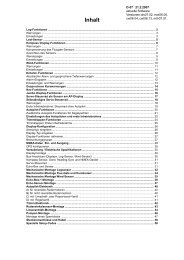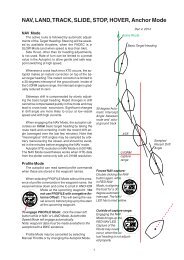Display Function - Marine Autopilots, Engine Controls and Instruments
Display Function - Marine Autopilots, Engine Controls and Instruments
Display Function - Marine Autopilots, Engine Controls and Instruments
Create successful ePaper yourself
Turn your PDF publications into a flip-book with our unique Google optimized e-Paper software.
How to purge a Linear<br />
Drive after installation<br />
Hydraulic Steering<br />
Pump Installation<br />
1. Verify that there is no air in the<br />
ram:<br />
Disconnect the pump motor from the Drivebox,<br />
but keep the Bypass Valve connected.<br />
Engage the autopilot now: the valve will<br />
close <strong>and</strong> lock the rudder. Try to move your<br />
helm or tiller with moderate force to Starboard,<br />
then reverse your force to Port. The<br />
piston rod should not move more than 1 mm<br />
(1/32 in.) if air has been purged completely.<br />
Otherwise you have to purge the air from the<br />
cylinder.<br />
2. Purging the last bit of air:<br />
Important: keep the purge valves closed (at<br />
the ram <strong>and</strong> the pump), do not use them.<br />
Disconnect the rudder sensor mechanically<br />
from the rudder, so it will not move, when the<br />
rudder moves.<br />
Further, we must be able to work the piston<br />
to the very end of the cylinder, both sides.<br />
This will normally necessitate detaching the<br />
piston rod from the tiller arm or quadrant. Or<br />
else we might hit a mechanical rudder stop,<br />
before the cylinder reaches its limit.<br />
Rotate the sensor shaft so as to get a center<br />
position on the LED of the autopilot display.<br />
With the motor <strong>and</strong> the valve reconnected<br />
to the Drivebox, engage the autopilot in Heading<br />
Mode (make sure the heading does not<br />
change <strong>and</strong> the boat is moored firmly).<br />
Turn the sensor shaft about three degrees<br />
to either side, this will start the pump. Don't<br />
turn the sensor too far or the autopilot will<br />
disengage. Stay there until the piston hits the<br />
cylinder end firmly. Then turn the sensor shaft<br />
quickly back to reverse the pump, <strong>and</strong> stay<br />
there, until the piston hits the other end of the<br />
ram. Repeat that 10 times with full rudder<br />
speed.<br />
3. Verify again according step 1<br />
above!<br />
The electric pump is normally mounted<br />
near the steering cylinder. Three hydraulic<br />
hoses are required, to connect it to the steering<br />
system. The wheel pump must have check<br />
valves installed or the Steering Wheel will<br />
start turning, when pressure builds up from<br />
the electric pump. Some wheel pumps don't<br />
have check valves; they require installation of<br />
a check valve block next to the wheel pump.<br />
Boats with two hydraulic steering wheels<br />
have check valves already installed.<br />
After making the required hydraulic connections,<br />
the system needs to be filled with oil.<br />
Automatic transmission fluid for automobiles<br />
has to be used. Purge air according instructions<br />
for the steering system. Eventually repeat<br />
purging after brief operation of the autopilot<br />
or Servo Steering. Some autopilot pump<br />
models allow purging at the pump itself. In<br />
case of pressurised hydraulic systems, do not<br />
exceed the prescribed air pressure.<br />
Adjustment of pump flow<br />
Some pumps permit to adjust mechanically<br />
their flow, to vary the maximum available rudder<br />
speed. Always select the maximum<br />
pump flow.<br />
Maximum Rudder Speed Selection<br />
A high maximum rudder speed is desirable<br />
for good autopilot function. However it is a<br />
must for Servo Steering. A low maximum rudder<br />
speed can lead to heading oscillations.<br />
!<br />
Danger! Therefore the maximum available<br />
rudder speed should always be<br />
selected. The Tecnautic Drive-Box is<br />
regulating the pump speed electronically <strong>and</strong><br />
reducing rudder speed automatically, whenever<br />
necessary.<br />
WARNING:<br />
If the autopilot does not keep the selected<br />
heading (in HDG mode), the first thing to<br />
check is the stiffness of the hydraulic system.<br />
Switch off the autopilot <strong>and</strong> the electronic<br />
servo steering. Then apply physical force onto<br />
the rudder with the emrgency tiller. Do NOT(!)<br />
use the hydraulic helm. The piston should not<br />
move more than 1 mm (1/32") at maximum.<br />
46




